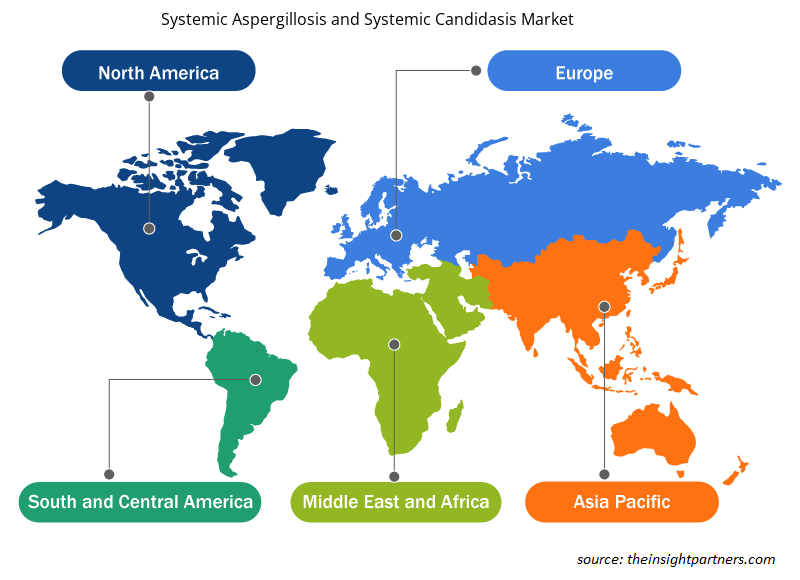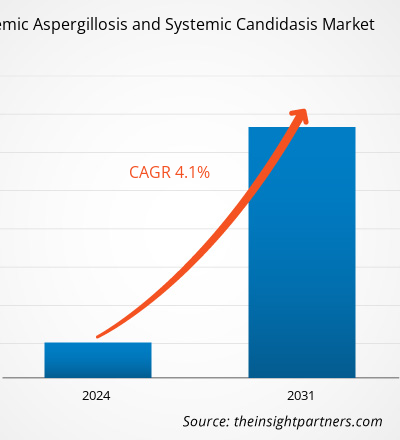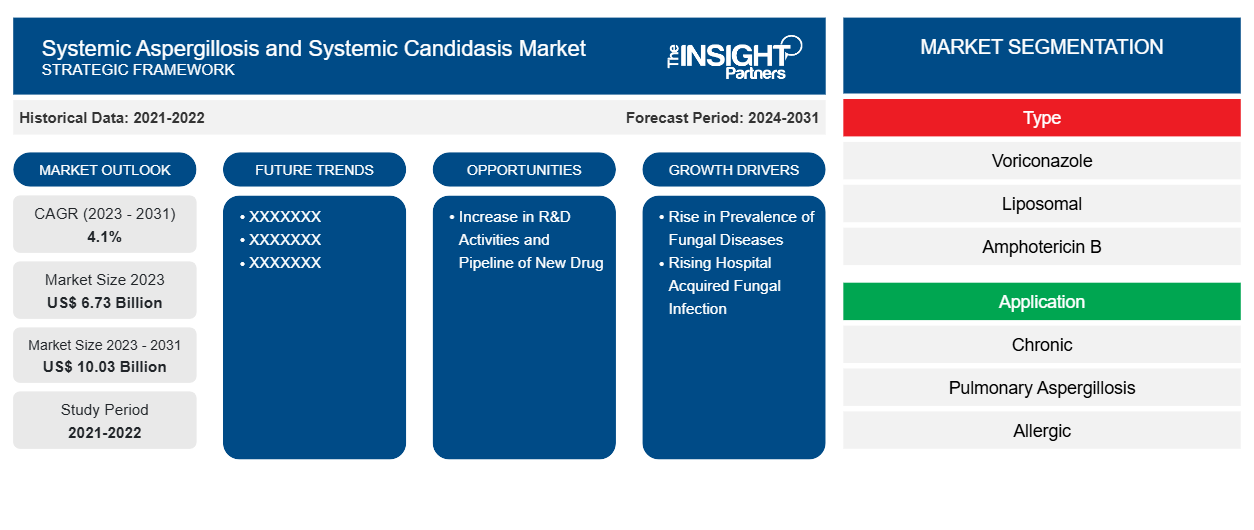La taille du marché de l’aspergillose systémique et de la candidose systémique devrait atteindre 10,03 milliards USD d’ici 2031, contre 6,73 milliards USD en 2023. Le marché devrait enregistrer un TCAC de 4,1 % en 2023-2031. Le développement de nouvelles thérapies pour le traitement des maladies fongiques, l’augmentation des activités de R&D pour le développement de médicaments et l’augmentation des maladies fongiques contractées à l’hôpital devraient rester les principales tendances du marché de l’aspergillose systémique et de la candidose systémique.
Analyse du marché de l'aspergillose systémique et de la candidose systémique
La prévalence de l'aspergillose systémique et de la candidose systémique augmente en raison de l'augmentation des problèmes de santé. Le système immunitaire étant affaibli par la pandémie du VIH/SIDA, la tuberculose, la bronchopneumopathie chronique obstructive (BPCO), l'asthme et l'incidence croissante des cancers, le patient est plus sensible aux maladies fongiques. Ainsi, l'augmentation de la prévalence des maladies qui affaiblissent le système immunitaire alimente la croissance du marché de l'aspergillose systémique et de la candidose systémique.
Aperçu du marché de l'aspergillose systémique et de la candidose systémique
Les infections systémiques fongiques sont fréquentes chez les patients dont le système immunitaire est affaibli, notamment les patients immunodéprimés et atteints du syndrome d'immunodéficience acquise (SIDA). Les signes systémiques comprennent l'apnée, les selles positives au gaïac, la distension abdominale, l'hyperglycémie, la réaction leucémoïde, l'hypotension et d'autres. Le traitement de la candidose systémique et de l'aspergillos nécessite un traitement antifongique parentéral et cette affection est associée à un taux de mortalité élevé. De plus, cette infection peut entraîner des déficits neurodéveloppementaux permanents chez les survivants à long terme.
Personnalisez ce rapport en fonction de vos besoins
Vous bénéficierez d'une personnalisation gratuite de n'importe quel rapport, y compris de certaines parties de ce rapport, d'une analyse au niveau des pays, d'un pack de données Excel, ainsi que de superbes offres et réductions pour les start-ups et les universités.
-
Obtenez les principales tendances clés du marché de ce rapport.Cet échantillon GRATUIT comprendra une analyse de données, allant des tendances du marché aux estimations et prévisions.
Moteurs et opportunités du marché de l'aspergillose systémique et de la candidose systémique
L'augmentation des infections fongiques contractées à l'hôpital favorise le marché
Candida Auris est un champignon qui constitue une menace sanitaire mondiale grave. C. Auris provoque une maladie grave chez les patients hospitalisés dans plusieurs pays, dont les États-Unis. Les patients atteints de C. auris ont provoqué des épidémies dans les établissements de santé et peuvent se propager par contact avec des patients affectés et des surfaces ou équipements contaminés. peut rester colonisé par C. Auris pendant une longue période, et C. Auris peut persister sur les surfaces dans les environnements de soins de santé. Cela peut entraîner la propagation de C. Auris entre les patients des établissements de santé. Selon un rapport des CDC de 2021, des cas américains de C. Auris ont été découverts chez des patients ayant récemment séjourné dans des établissements de santé en Égypte, en Inde, au Kenya, au Koweït, au Pakistan, en Afrique du Sud, en Corée du Sud, aux Émirats arabes unis et au Venezuela, qui ont également documenté des cas.Auris is a fungus that causes a serious global health threat. C. Auris causes severe illness in hospitalized patients in several countries, including the United States. Patients C. auris has caused outbreaks in healthcare facilities and can spread through contact with affected patients and contaminated surfaces or equipment. can remain colonized with C. Auris for a long time, and C. Auris can persist on surfaces in healthcare environments. This can result in the spread of C. Auris between patients in healthcare facilities. According to a CDC report of 2021, U.S. cases of C. Auris have been found in patients who had recent stays in healthcare facilities in Egypt, India, Kenya, Kuwait, Pakistan, South Africa, South Korea, the United Arab Emirates, and Venezuela, which also have documented cases.
Analyse de pipeline – Une opportunité de personnalisation de l’aspergillose systémique et de la candidose systémiqueCustomisation of Systemic Aspergillosis and Systemic Candidasis
Le paysage actuel de l’aspergillose systémique et de la candidose systémique est prometteur, avec de multiples approbations de médicaments, un riche pipeline et de nombreux essais cliniques en cours. Les pipelines de l’aspergillose systémique et de la candidose systémique sont à divers stades de développement clinique ; les principales sociétés pharmaceutiques travaillent à faire progresser l’espace pipeline et le potentiel de croissance future du domaine concurrentiel de l’aspergillose systémique et de la candidose systémique. Par exemple, le citrate d’Ibrexafungerp, un médicament pour le traitement de la candidose systémique, est actuellement en phase III et est développé par Scynexis.aspergillosis and systemic candidasis is promising, with multiple drug approvals, a rich pipeline, and many ongoing clinical trials. Pipelines of systemic aspergillosis and systemic candidasis are in various stages of clinical development; major pharmaceutical companies are working to advance the pipeline space and future growth potential of the systemic aspergillosis and systemic candidasis competitive domain. For instance, Ibrexafungerp Citrate, a drug for treatment of systemic candidiasis, is currently in phase III and is developed by Scynexis.
Analyse de segmentation du rapport sur le marché de l'aspergillose systémique et de la candidose systémiqueAspergillosis and Systemic Candidasis Market Report Segmentation Analysis
Les segments clés qui ont contribué à la dérivation de l’analyse du marché de l’aspergillose systémique et de la candidose systémique sont le type et l’application.Aspergillosis and Systemic Candidasis Market analysis are type and application.
- En fonction du type, le marché de l'aspergillose systémique et de la candidose systémique est divisé en voriconazole, amphotéricine B liposomale, azoles oraux systémiques, agents antifongiques topiques et autres. Le segment des azoles oraux systémiques détenait la plus grande part de marché en 2023. Les médicaments azolés oraux tels que le fluconazole, le kétoconazole et l'itraconazole représentent une avancée majeure dans le traitement antifongique systémique. Parmi les trois, le fluconazole présente le profil pharmacologique (pharmacocinétique et pharmacodynamique) le plus attrayant, notamment la capacité de produire des concentrations élevées de médicament actif dans le liquide céphalo-rachidien et l'urine.Aspergillosis and Systemic Candidasis Market is divided into voriconazole, liposomal amphotericin b, systemic oral azoles, topical antifungal agents and others. The systemic oral azoles segment held the largest market share in 2023. Oral azole drugs such as fluconazole, ketoconazole, and itraconazole have a major advancement in systemic antifungal therapy. Among all the three, fluconazole has the most attractive pharmacologic (pharmacokinetics and pharmacodynamic) profile, including the capacity to produce high concentrations of active drug in cerebrospinal fluid and urine.
- En fonction des applications, le marché est segmenté en aspergillose pulmonaire chronique (CPA), aspergillose bronchopulmonaire allergique (ABPA), candidose gastro-intestinale , voies génito-urinaires, candidose et autres. Le segment de l'aspergillose bronchopulmonaire allergique (ABPA) détenait la plus grande part du marché en 2023.
Analyse des parts de marché de l'aspergillose systémique et de la candidose systémique par géographie
La portée géographique du rapport sur le marché de l’aspergillose systémique et de la candidose systémique est principalement divisée en cinq régions : Amérique du Nord, Asie-Pacifique, Europe, Moyen-Orient et Afrique, et Amérique du Sud/Amérique du Sud et centrale.
L'Amérique du Nord a dominé le marché de l'aspergillose systémique et de la candidose systémique. La croissance du marché de la région est attribuée à l'augmentation de l'incidence des infections fongiques et au développement et au lancement croissants de produits, ainsi qu'aux initiatives croissantes concernant les infections fongiques et leurs traitements. En outre, les dépenses de santé croissantes pour le traitement des infections fongiques devraient stimuler la croissance du marché au cours de la période de prévision jusqu'à la domination du marché nord-américain de l'aspergillose systémique et de la candidose systémique. On estime que les États-Unis sont le plus grand marché pour l'aspergillose systémique et la candidose systémique. La croissance est attribuée à l'augmentation de l'incidence des infections fongiques qui encouragent davantage diverses sociétés pharmaceutiques à investir dans leurs programmes de R&D et à introduire des médicaments de traitement innovants sur le marché. Par exemple, en janvier 2020, Astellas Pharma Inc. a annoncé avoir reçu l'approbation de la FDA pour sa demande supplémentaire de nouveau médicament (sNDA) pour MYCAMINE (micafungine pour injection). L'Asie-Pacifique devrait connaître le TCAC le plus élevé dans les années à venir.
Aperçu régional du marché de l'aspergillose systémique et de la candidose systémique
Les tendances et facteurs régionaux influençant le marché de l’aspergillose systémique et de la candidose systémique tout au long de la période de prévision ont été expliqués en détail par les analystes d’Insight Partners. Cette section traite également des segments et de la géographie du marché de l’aspergillose systémique et de la candidose systémique en Amérique du Nord, en Europe, en Asie-Pacifique, au Moyen-Orient et en Afrique, ainsi qu’en Amérique du Sud et en Amérique centrale.

- Obtenez les données régionales spécifiques au marché de l'aspergillose systémique et de la candidose systémique
Portée du rapport sur le marché de l'aspergillose systémique et de la candidose systémique
| Attribut de rapport | Détails |
|---|---|
| Taille du marché en 2023 | 6,73 milliards de dollars américains |
| Taille du marché d'ici 2031 | 10,03 milliards de dollars américains |
| Taux de croissance annuel composé mondial (2023-2031) | 4,1% |
| Données historiques | 2021-2022 |
| Période de prévision | 2024-2031 |
| Segments couverts |
Par type
|
| Régions et pays couverts |
Amérique du Nord
|
| Leaders du marché et profils d'entreprises clés |
|
Densité des acteurs du marché : comprendre son impact sur la dynamique des entreprises
Le marché de l'aspergillose systémique et de la candidose systémique connaît une croissance rapide, tirée par la demande croissante des utilisateurs finaux en raison de facteurs tels que l'évolution des préférences des consommateurs, les avancées technologiques et une plus grande sensibilisation aux avantages du produit. À mesure que la demande augmente, les entreprises élargissent leurs offres, innovent pour répondre aux besoins des consommateurs et capitalisent sur les tendances émergentes, ce qui alimente davantage la croissance du marché.
La densité des acteurs du marché fait référence à la répartition des entreprises ou des sociétés opérant sur un marché ou un secteur particulier. Elle indique le nombre de concurrents (acteurs du marché) présents sur un marché donné par rapport à sa taille ou à sa valeur marchande totale.
Les principales entreprises opérant sur le marché de l'aspergillose systémique et de la candidose systémique sont :
- Novartis SA
- Sanofi-Aventis
- Pfizer, Inc
- Merck et Cie., Inc.
- Enzon Pharmaceuticals, Inc
- Bayer AG
Avis de non-responsabilité : les sociétés répertoriées ci-dessus ne sont pas classées dans un ordre particulier.

- Obtenez un aperçu des principaux acteurs clés du marché de l'aspergillose systémique et de la candidose systémique
Actualités et développements récents du marché de l'aspergillose systémique et de la candidose systémique
Le marché de l'aspergillose systémique et de la candidose systémique est évalué en collectant des données qualitatives et quantitatives après des recherches primaires et secondaires, qui comprennent d'importantes publications d'entreprise, des données d'association et des bases de données. Voici une liste des développements sur le marché de l'aspergillose systémique et de la candidose systémique et des stratégies :
- Pfizer a acquis Amplyx Pharmaceuticals, Inc. Pfizer a acquis la propriété du pipeline en phase de démarrage d'Amplyx, qui comprend des thérapies antivirales (MAU868) et antifongiques (APX2039) potentielles. (Source : Pfizer, communiqué de presse, 2021)
- Basilea Pharmaceutica Ltd a conclu un accord d'achat d'actifs avec Amplyx Pharmaceuticals, Inc., une filiale de Pfizer Inc., qui a acquis les droits sur le fosmanogepix, un candidat antifongique à large spectre en phase clinique. De plus, Basilea a acquis les droits sur un composé antifongique préclinique. (Source : Biospace, Communiqué de presse, 2023)
Rapport sur le marché de l'aspergillose systémique et de la candidose systémique, couverture et livrables
Le rapport « Taille et prévisions du marché de l’aspergillose systémique et de la candidose systémique (2021-2031) » fournit une analyse détaillée du marché couvrant les domaines ci-dessous :
- Taille du marché et prévisions aux niveaux mondial, régional et national pour tous les segments de marché clés couverts par le périmètre
- Dynamique du marché, comme les facteurs moteurs, les contraintes et les opportunités clés
- Principales tendances futures
- Analyse détaillée des cinq forces de PEST/Porter et SWOT
- Analyse du marché mondial et régional couvrant les principales tendances du marché, les principaux acteurs, les réglementations et les développements récents du marché
- Analyse du paysage industriel et de la concurrence couvrant la concentration du marché, l'analyse de la carte thermique, les principaux acteurs et les développements récents
- Profils d'entreprise détaillés
- Analyse historique (2 ans), année de base, prévision (7 ans) avec TCAC
- Analyse PEST et SWOT
- Taille du marché Valeur / Volume - Mondial, Régional, Pays
- Industrie et paysage concurrentiel
- Ensemble de données Excel
Rapports récents
Témoignages
Raison d'acheter
- Prise de décision éclairée
- Compréhension de la dynamique du marché
- Analyse concurrentielle
- Connaissances clients
- Prévisions de marché
- Atténuation des risques
- Planification stratégique
- Justification des investissements
- Identification des marchés émergents
- Amélioration des stratégies marketing
- Amélioration de l'efficacité opérationnelle
- Alignement sur les tendances réglementaires























 Obtenez un échantillon gratuit pour - Marché de l'aspergillose systémique et de la candidose systémique
Obtenez un échantillon gratuit pour - Marché de l'aspergillose systémique et de la candidose systémique